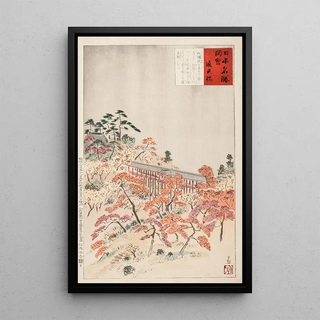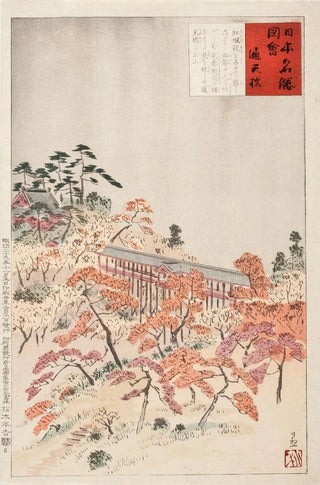Art print | The Tōstenky Bridge Kyoto - Kobayashi Kiyochika Source: Reproduction | Le pont Tōstenky Kyoto - Kobayashi Kiyochika


View from behind

Frame (optional)
The Tōstenky Bridge in Kyoto: a journey through time and space
The Tōstenky Bridge in Kyoto, an iconic work by Kobayashi Kiyochika, transports us to a world where nature and architecture meet harmoniously. The delicate composition of this art print highlights soft colors, shades of blue and green that evoke the serenity of Japanese landscapes. The technique of printmaking on paper, characteristic of the artist, gives the piece a peaceful, almost meditative atmosphere. The meticulous details of the bridge and surrounding elements invite prolonged contemplation, allowing the viewer to immerse themselves in the ephemeral beauty of this moment frozen in time.
Kobayashi Kiyochika: a master of Japanese printmaking
Kobayashi Kiyochika, active during the Meiji period, is renowned for his ability to fuse tradition and modernity in his works. Influenced by Western techniques while remaining rooted in Japanese culture, Kiyochika captured the essence of his era. His art prints, often focused on urban landscapes and scenes of daily life, demonstrate a deep respect for nature and the beauty of everyday life. The artist played a crucial role in the transition of Japanese art towards more contemporary forms, while preserving the legacy of previous masters. His work remains an essential reference for understanding the evolution of Japanese art.
A decorative acquisition with multiple advantages
The art print of the Tōstenky Bridge in Kyoto is an ideal decorative piece to enhance your living room, office, or bedroom. Its print quality and fidelity to the original details make this artwork a wise choice for lovers of art and Japanese culture. The aesthetic appeal of this canvas lies in its ability to bring a touch of elegance and serenity to any space. By incorporating this piece into your interior decor, you not only invite a fragment of Japanese artistic history but also create a calming atmosphere that will captivate your guests.

Matte finish

View from behind

Frame (optional)
The Tōstenky Bridge in Kyoto: a journey through time and space
The Tōstenky Bridge in Kyoto, an iconic work by Kobayashi Kiyochika, transports us to a world where nature and architecture meet harmoniously. The delicate composition of this art print highlights soft colors, shades of blue and green that evoke the serenity of Japanese landscapes. The technique of printmaking on paper, characteristic of the artist, gives the piece a peaceful, almost meditative atmosphere. The meticulous details of the bridge and surrounding elements invite prolonged contemplation, allowing the viewer to immerse themselves in the ephemeral beauty of this moment frozen in time.
Kobayashi Kiyochika: a master of Japanese printmaking
Kobayashi Kiyochika, active during the Meiji period, is renowned for his ability to fuse tradition and modernity in his works. Influenced by Western techniques while remaining rooted in Japanese culture, Kiyochika captured the essence of his era. His art prints, often focused on urban landscapes and scenes of daily life, demonstrate a deep respect for nature and the beauty of everyday life. The artist played a crucial role in the transition of Japanese art towards more contemporary forms, while preserving the legacy of previous masters. His work remains an essential reference for understanding the evolution of Japanese art.
A decorative acquisition with multiple advantages
The art print of the Tōstenky Bridge in Kyoto is an ideal decorative piece to enhance your living room, office, or bedroom. Its print quality and fidelity to the original details make this artwork a wise choice for lovers of art and Japanese culture. The aesthetic appeal of this canvas lies in its ability to bring a touch of elegance and serenity to any space. By incorporating this piece into your interior decor, you not only invite a fragment of Japanese artistic history but also create a calming atmosphere that will captivate your guests.






